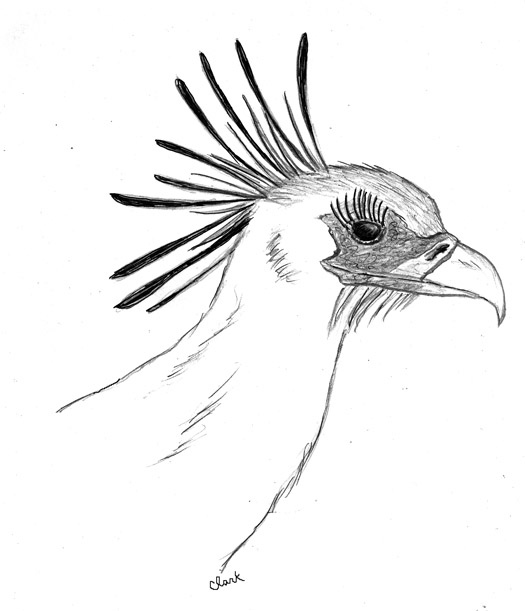
Dear Bird Folks,
Being an eye doctor, I have been wondering how birds protect their eyes while flying. They must come into contact with swarming insects, yet very few of them appear to have eyelashes. Also, how are they able to keep their eyes from drying out while in flight?
– Karen, Boxford, MA
Thanks, Karen,
Thanks for the questions about birds’ eyes, but shouldn’t I be asking you these questions, doctor? I know a lot about birdseed and squirrel baffles, but I never really did that well in biology. (I always felt bad for the dissected frogs.) As for birds and eyelashes, that’s a topic that is rarely discussed, since few birds are so equipped. It seems evolution has determined most birds simply don’t need lashes, which I think is a mistake. I mean, how can birds flirt without being able to bat their eyelashes? Think about it. If Betty Boop didn’t have her famous eyelashes, she never would have become a star and might have ended up working at the thread counter at Woolworth’s. That would have been a big loss for the entertainment world, although Woolworth’s would have sold a lot more thread.
Since human eyelashes are modified hairs, it stands to reason that bird eyelashes are modified feathers. An informal Cornell study tells us that only a small percentage of birds have eyelashes, and those particular birds tend to be fairly large ground-dwellers. The two most noted eyelash-wearing species are Africa’s ostriches and Secretarybirds. I totally understand the ostriches’ need for lashes; something has to protect their eyes from sand every time they bury their heads. But the species that caught my attention is the Secretarybird. Known for its long legs and elaborate head plumes, the Secretarybird also has amazing eyelashes. Why do they need them? Secretarybirds are related to hawks and eagles, but instead of searching for prey from the air, these big birds are terrestrial hunters. They typically move through tall grass searching for insects, mice and snakes. It is thought the long lashes help to protect the birds’ eyes from prickly grass, while making them look fabulous at the same time.
When our eyes need to be moistened or feel itchy, we blink. The top eyelid drops down and meets the bottom lid. With most birds, except owls, the top lid is fixed and it’s the bottom lid that rises up. But here’s the thing: birds only close their eyes to sleep. When they blink, believe it or not, their eyes actually remain open. How is that possible, you ask? Unlike us, birds have a “third eyelid.” The third eyelid sounds like the name of a sixties head shop, but it’s actually a clear to semi-transparent film that is more accurately known as a nictitating membrane. When a bird wants to moisten its eyes or wipe away any irritants, the membrane appears out of nowhere and slides across laterally, like a windshield wiper or closing a shower curtain. Special glands provide secretions that both lubricate and nourish the front of the eyeball, which you professionals probably call the cornea.
In addition to allowing birds to lube up their eyeballs, the nictitating membrane also serves another important function. It provides birds with natural safety goggles. The membrane closes when hawks are catching prey, when woodpeckers are pecking wood and when hummingbirds are fighting over our feeders. For loons and other diving birds, the membrane functions as swimming goggles, protecting the bird’s eyes from both seawater and any thrashing fish that is unhappy about being caught. It is also thought that migrating birds use their third eyelids as Lindbergh-style aviator goggles, shielding their eyes from impurities and from drying out during long flights. How often and how long birds use their nictitating membranes during these flights is not totally known…at least not to me.
I was told that when small birds moistened their eyes it happens so quickly we can’t detect it. I didn’t believe that or even care, until I started taking photographs. Now I care. Some of my best pics have been ruined by blinking birds. Nobody wants to see a photo of a bird with its eyes coated by a milky membrane. It looks like an avian zombie or a bird that needs cataract surgery. (That last line was for all the optometrists out there.)
Eyelashes are a relatively minor feature on birds, Karen. The real eye protection comes from their multi-functioning nictitating membrane. It provides both safety goggles and drops of Visine at the same time. And while we are on the topic, if you get a chance, look up photos of the Secretarybird’s eyelashes. You’ll be impressed. Meanwhile, I’ll be looking up pictures of Betty Boop… but purely for research purposes.
On a different note:
For the last forty-five years, for an assortment of reasons, I have lived in the same house as my mother-in-law, whom I eventually called “Gram.” That sounds like a punishment to some folks, but not in this case. Living with Gram was good, always good. In fact, it was watching the chickadees on her homemade bird feeder that first got me interested in birds. As time went on, it became my job to fill her feeder each morning. It was also my job to bring her feeder inside in the evening, so the raccoons wouldn’t steal it. This morning and evening routine continued for years…until last night, when I brought her bird feeder into the house for the last time. RIP, Gram. Thanks for turning me on to birds.